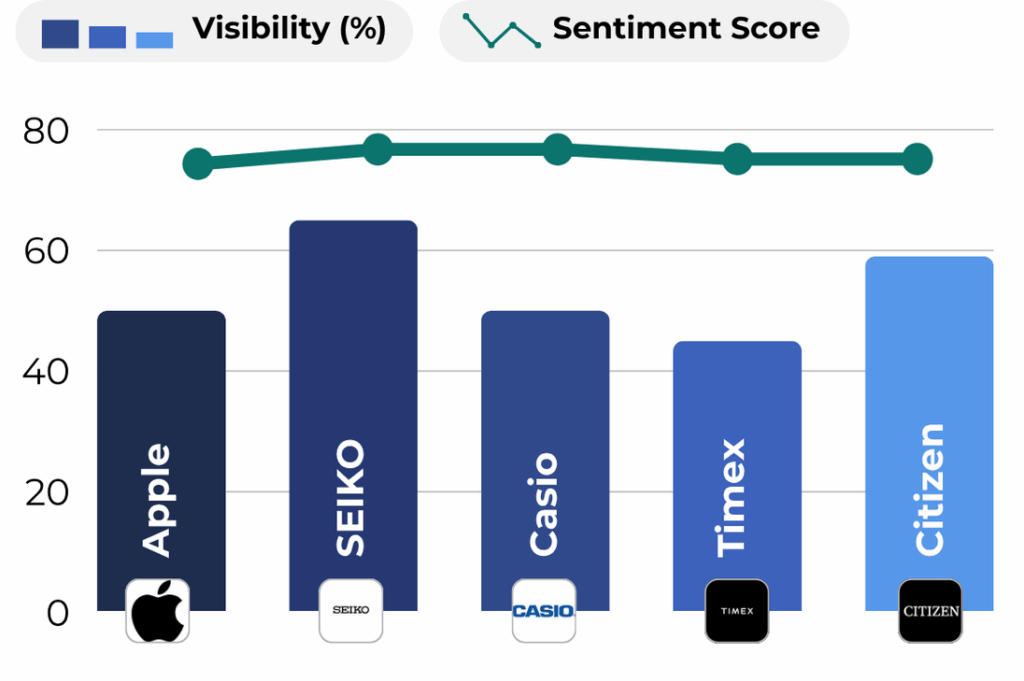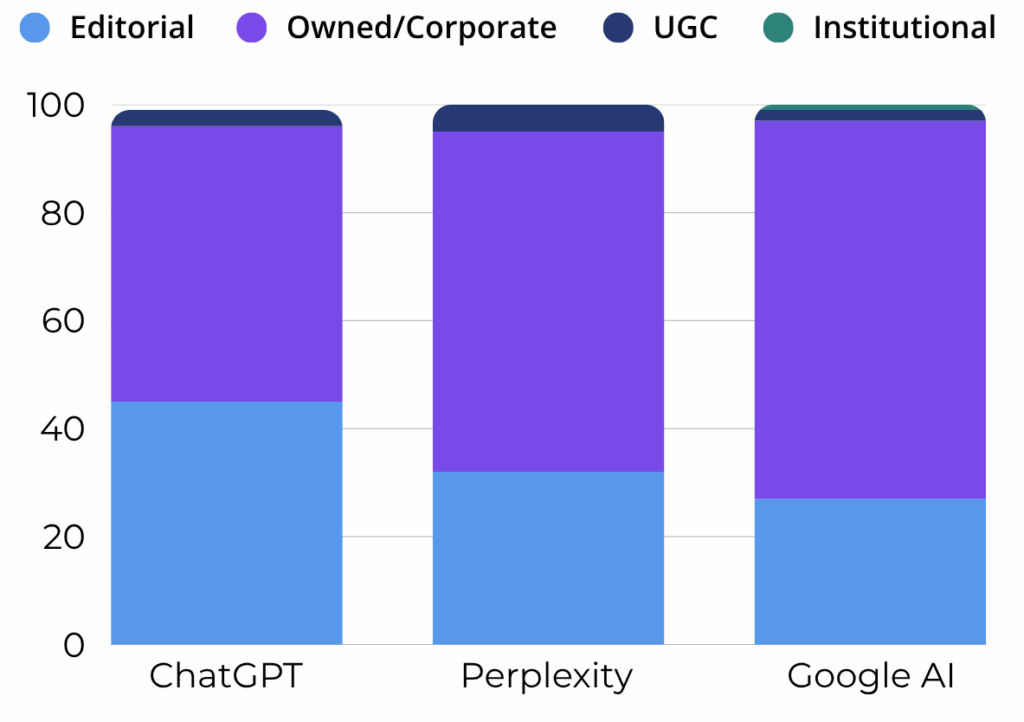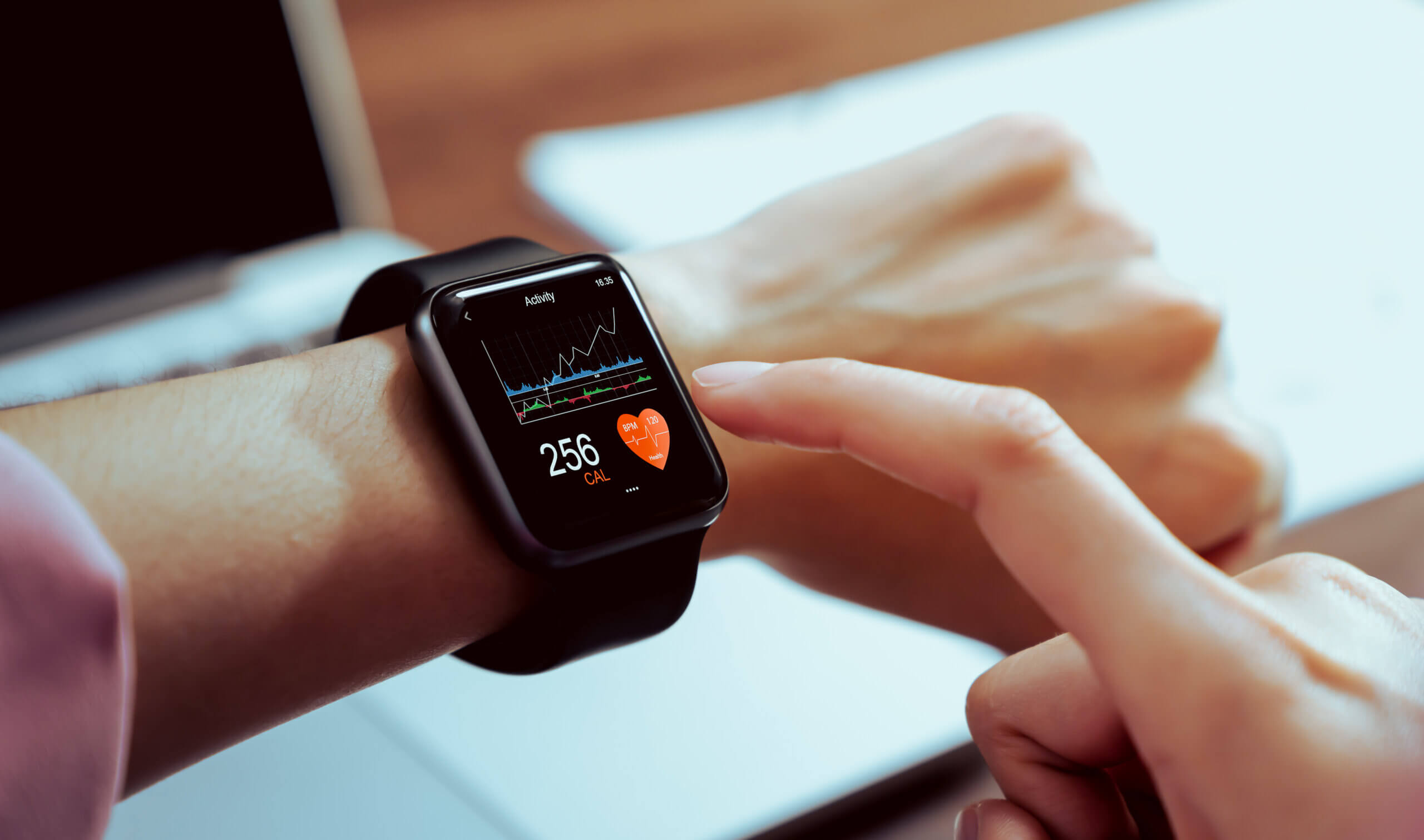See Which Watch Brands Rank in AI
AI is reshaping how brands are found – dictating what consumers see, trust, and ultimately buy. Visibility within AI systems now impacts every stage of the customer journey, influencing traffic, reputation, and revenue.
The Holiday Watchlist: Which Watch & Wearable Brands AI Recommends This Holiday Gifting Season
A new Avenue Z study uncovers how leading watch and wearable brands stack up in the world of AI-driven search results. The findings reveal surprising insights into what makes brands “click” with LLMs – and what leaves others out of the conversation.
New data reveals how LLMs rate major watch and wearable brands across the U.S. market
When someone asks ChatGPT or Google’s AI, “What’s the best smartwatch?” the brands that appear first aren’t random. They’re the result of a complex interplay between reputation, structured content, and what AI models “believe” to be trusted sources.
Avenue Z’s new AI Visibility Study examined how 18 major watch and wearable brands perform across three leading AI platforms – ChatGPT, Google’s AI Overviews, and Perplexity – weighted for real-world consumer relevance (50%, 30%, and 20% respectively). The findings tell a story of a few standout brands thriving in AI search, while others struggle to make it onto the radar at all.
AI Visibility is the New Frontline for Watch Brands
AI is becoming the first stop for purchase research, fitness advice, and tech comparisons – and watches and wearables are among the hottest categories. The study shows a high concentration of AI attention on just a handful of brands, while others barely get mentioned.
Two factors stand out: AI strongly favors brands that appear in credible editorial lists and that have well-structured official product pages. The takeaway? It’s no longer just about search engine optimization; it’s about AI engine optimization.
Watch-able Stats from the Study
- 70% of all AI mentions across the three platforms went to just ten brands.
- Apple appeared in nearly 75% of AI responses, the widest reach by far.
- 20% of Perplexity’s citations came from forums and community discussions — higher than any other platform.
These findings paint a clear picture: AI assistants reward brands that blend strong editorial presence, detailed owned content, and engaged fan communities.
What Drives AI Visibility for Watch and Wearable Brands
AI systems don’t just “know” which brands are best — they learn from what the internet says. The top-performing brands share a combination of three key factors:
1. Credible Mentions Across Editorial Media
Brands featured in “Top Smartwatches of the Year” or “Best Fitness Trackers” lists are far more likely to be surfaced by AI. Publications like Wired, Men’s Health, and Forbes consistently shape AI results by establishing authoritative consensus.
2. Structured Product Data and SEO Foundations
Google’s AI Overviews frequently pull details from brand-owned sites — battery life, materials, compatibility, and health metrics. Brands like Garmin and Apple excel here because their websites are data-rich, well-structured, and AI-readable.
3. Community Sentiment and Word-of-Mouth Energy
Perplexity and ChatGPT both absorb user sentiment from community-driven content. Reddit threads, forums, and product reviews aren’t just chatter — they’re training data. Fitbit and Samsung benefit from this continuous feedback loop of enthusiastic (and sometimes critical) discussions.
Visibility vs Sentiment: The Surprising Disconnect
One of the most interesting findings in the study is that visibility doesn’t always equal love. Some brands show up often but receive neutral or mixed sentiment, while smaller niche brands with devoted fans earn glowing AI commentary despite lower visibility.
For example, Apple and Samsung appear frequently but often in neutral, factual contexts. In contrast, a few smaller players with cult followings — particularly among outdoor or performance users — have the highest sentiment scores, even if they rank mid-pack in overall mentions. This suggests that AI captures brand passion, not just brand size, a dynamic especially pronounced in the fitness tech space.

Where AI Gets Its Information: Source Patterns by Platform
Each large language model “trusts” a different mix of sources when forming answers:
- ChatGPT: Prefers community and consensus — Wikipedia, Reddit, and broad editorial reviews. Rarely cites brand websites.
- Perplexity: Blends expert and crowd. Pulls heavily from tech review outlets like TechRadar, CNET, and Android Authority, plus about 20% of citations from user discussions.
- Google AI Overviews: Leans heavily on brand-owned sites and authoritative publishers like PCMag or Wirecutter. It values structured data and official specs over opinions.

This variety means brands need a multi-front content strategy: structured data for Google, expert validation for Perplexity, and authentic community conversation for ChatGPT.
Unique Insights from the Watches & Wearables Sector
The wearables industry shows some fascinating AI patterns not seen in other verticals:
- Lifestyle-first framing: AI responses often mix wellness and fashion language, unlike other tech categories that emphasize performance specs.
- Absence of institutional citations: Unlike health or finance categories, no major AI system cited medical journals or clinical data — a reminder that wearables are positioned as consumer tech, not medical devices.
- High reliance on “best-of” listicles: This category’s discovery funnel runs through editorial lists far more than direct product searches.
- Brand storytelling matters: AI reflects brands that show personality — lifestyle videos, mission statements, and design stories often find their way into Perplexity and ChatGPT summaries.
- Community advocacy shapes presence: Watch and fitness communities have an outsized influence on AI mentions. Subreddits like r/Fitness or r/Watches are now critical for shaping AI’s view of what’s “trusted.”
Conclusion
The watches and wearables sector is proving that AI visibility isn’t accidental — it’s earned through credibility, clarity, and conversation. Brands that appear frequently in AI search results aren’t just lucky; they’ve strategically built ecosystems of trust across multiple content types.
As AI assistants become the first touchpoint for consumers, watch and wearable brands have a unique chance to shape how the next generation of buyers discovers them. The brands that make AI believe in them today will be the ones everyone else is asking about tomorrow.
How to Rank in AI Search – Consumer Electronics
Top Watches Brands
AI Z-Score Performance Rankings








